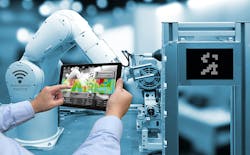The digital transformation of manufacturing, dubbed “Industry 4.0,” brings together a myriad of technologies, but the competitive advantage comes from making them work in harmony.
On the factory floor, transformative technologies include new sensing, control, and communication systems. They also involve functional safety and power-management capabilities that enable people to work smarter, take on new roles, and in some cases, work in closer proximity to robots in a much more integrated manner.
We’ve hit the tipping point at which we’re past the early adoption phase. Organizations are deploying at least some of these technologies in discrete parts of their business. The next step for those looking to further adopt Industry 4.0 technologies is to get them to work together (see figure). Accomplishing that requires an underlying foundation to unify their various intelligent capabilities.
Standards and specifications are critical to this unification. Not only do they create a long-term, competitive advantage for manufacturers by making systems interoperable and more efficient, but they also enable iterative learning. Connected, distributed devices can feed artificial intelligence (AI) and machine learning to evolve and optimize manufacturing operations.
Communication Enables Control
Technologies that keep the manufacturing floor humming fall into five broad categories: communication, sensing, control, safety, and power. These categories aren’t necessarily new, but Industry 4.0 proposes a scenario of seamless communication that harnesses innovations in each discrete area.
It should come as no surprise that functional safety and power management are critical considerations in a manufacturing environment. Keeping workers safe and conserving power are two of the most pressing priorities—when implemented successfully, they offer a competitive advantage. Power management is also tied to environmental control, making sure that temperatures and climates are conducive to specific types of manufacturing. Meanwhile, industrial communication, sensing, and control all enable people to work safely and more effectively while being mindful of power consumption.
Even with technological advances, industrial communication remains the most fundamental technology, because it enables a single control unit to manage multiple inputs and outputs (I/Os) through a network. The networked control architecture in a factory includes applications such as motor control, motion control, robotics, and classical programmable logic control (PLC).
A PLC provides a whole range of status information, including measurements, temperature, and position. A modern-day example of a PLC in action is a robot gripper picking up or modifying something on a conveyor. Robotic control is a special version of motor control that governs a multiaxis robot arm with its own ecosystem of sensing. Machine vision is used to position the robot arm, and combined with functional safety, enables operators to monitor the environment and ensure safe operation for people working near robots.
Such a level of safety and precision requires both communications and processing power. For example, Texas Instruments’ (TI) SitaraAM6x processor family, with Arm Cortex-A53 and Cortex-R5F cores, enables gigabit industrial Ethernet networks and includes safety diagnostic libraries. Sitara processors help enable functional safety systems and support the intelligence that helps dynamically control and optimize production in a smart factory, while also being energy-efficient.
Sitara processors are part of a system with a broader set of interactions that aren’t possible unless various control systems can talk to each other. Before specifications like time-sensitive networking (TSN) and IO-Link, I/Os traversed separate analog paths. Different control systems acted as their own isolated islands of activity.
TSN is a set of standards that fall under three main component categories necessary for complete real-time communication:
- Time synchronization
- Scheduling and traffic shaping
- Selection of communication paths, path reservations, and fault tolerance
Traffic shaping is related to Ethernet packets in a network with different priority. Some packets get higher priority (real-time) compared to other packets (non-real time). Depending on the application, priority can be determined by type of packet, arrival time of packet, or bandwidth of a packet. Traffic shaping is sometimes compared with road traffic HOV lanes—a fast path crossing an intersection.
TSN is aptly named in that it understands all devices on the network must be in sync, whether it’s a PLC or a robot. Furthermore, every device follows the same rules for processing and forwarding communication packets, with redundancy to guarantee fault tolerance.
International Electrotechnical Commission 61131-9T establishes the bidirectional, digital, point-to-point IO-Link industrial communications networking standard. IO-Link connects digital sensors and actuators to either a type of industrial fieldbus or a type of industrial Ethernet, wired or wirelessly, over short distances and sometimes in less-than-ideal conditions.
For example, TI’s DP83867 physical-layer transceiver meets the time-synchronization needs of Industry 4.0. However, it’s also designed to facilitate implementation of 10-/100-/1,000-Mb/s Ethernet local-area networks in harsh environments by interfacing directly to twisted-pair media through an external transformer.
Together with TSN, IO-Link supports the use of sensors and actuators that can produce and consume enriched data sets in real time—necessary for the intelligence to optimize manufacturing and support digital transformation.
Unified Comms is the Backbone of Industry 4.0
Unified systems communication through TSN and IO-Link has digitized production systems in the field in real time, realizing many different Industry 4.0 capabilities.
It goes beyond just being able to do more, and do it faster, at one assembly station, or even linking the control systems of those stations together. Unified communication also improves machine availability because it supports predictive maintenance. Not only can you run multiple control systems, including PLC, motion control, and machine vision, over a single TSN backbone, but you can service those systems and diagnose any issues from a central point. The various parts now speak the same language, rather than having separate systems with separate communications protocols.
Plus, real-time data exchange enables comparability or compatibility between various areas of production. Data moves fluidly from a robot control to a PLC controller to a machine tool, thus increasing the overall efficiency of the production system.
Furthermore, Industry 4.0 offers full transparency because it feeds production data into enterprise-resource-planning (ERP) systems. And although an ERP system doesn’t directly control how quickly a product is made on the floor, the existence of more business intelligence enables manufacturers to make smarter decisions, with data to inform manufacturing performance and how it may impact costs and profitability.
Deciding Where the Data Goes
Data science also plays a big role in Industry 4.0. By getting control systems to talk to each other, organizations have more information to work with to make smarter decisions—optimizing manufacturing in alignment with business objectives. Because every device and every I/O produces data, it’s now possible to know almost immediately if a system requires maintenance to prevent disruptions.
The integration of control systems through a common communications protocol is also changing how people and machines work on the factory floor. Although advanced robotics are taking over some tasks once performed by people, data scientists are becoming more involved with the manufacturing process, and other workers can collaborate in closer proximity to robots.
The enormous amount of data available can sometimes exceed the bandwidth available to ship to a central point for processing. Having a holistic view through cloud-based business applications is one of the hallmarks of Industry 4.0, but that doesn’t mean that every piece of information sails into the cloud—real-time communication primarily exists only on the production floor. Even over the long term, it doesn’t make sense to ship all data to a central point.
Rather, the goal is to add more intelligence to devices inside the production environment. The data generated inside motor applications is at an even higher data rate and requires local pre-processing and sometimes even local analytics inside the motor controller. Not all data goes to the cloud.
Conclusion
Ultimately, Industry 4.0 has three potential scenarios. One is that everything is sent to the cloud because the bandwidth is available. Another is the extreme opposite, wherein everything is processed and decisions are made at the edge, because the deluge of data is so great that it can’t be sent to the cloud.
The third—and most likely the best option—is a hybrid solution: a combination of pre-processing capabilities embedded in the edge hardware that send compressed data to the cloud for decision-making through standardized communications. This scenario best supports distributed machine learning and practical use of AI on the manufacturing floor, while also benefitting the supply chain.
Thomas Leyrer is System Engineer, Factory Automation and Control, at Texas Instruments.
About the Author
Thomas Leyrer
System Engineer, Factory Automation and Control, Texas Instruments
Thomas Leyrer is a System Architect for TI’s industrial communication solutions. He’s responsible for the development of solutions for the industrial automation market, including fieldbus and industrial Ethernet on TI embedded processors. Thomas has more than 25 years of experience with TI’s semiconductor group. He has held several engineering and application manager positions for the computer, automotive, broadband-communication, and industrial-automation markets.
Thomas is an advocate of Linux Open Source and system architect for industrial communication on ARM SoCs. He holds an engineering degree in Electrical Engineering from FH Landshut.

